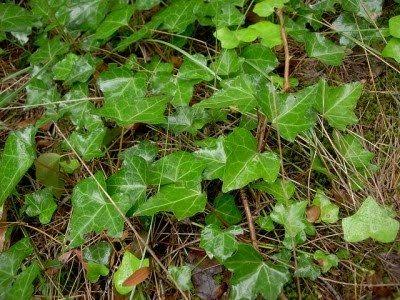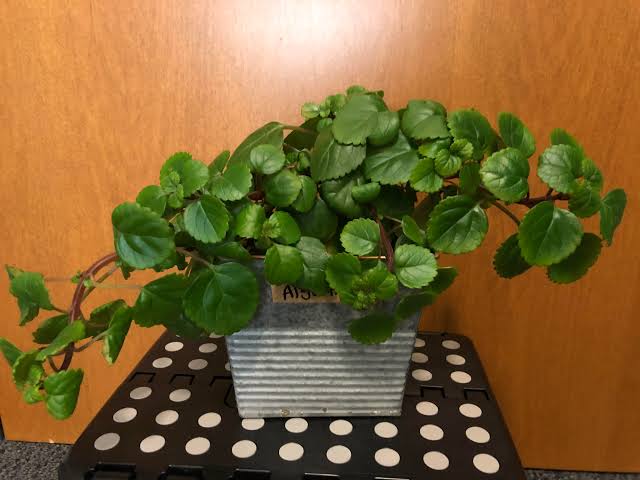Ivy Plant
Ivy plant is, any plant of the genus Hedera, with about five species of evergreen woody vines (rarely shrubs), in the ginseng family (Araliaceae). The name ivy especially denotes the commonly grown English ivy (H. helix), which climbs by aerial roots with adhering disks that develop on the stems. English ivy is frequently planted to clothe brick walls. The stems bear leaves with three to five lobes; as the stems reach the top of their support, they become horizontal or hang, sometimes developing unlobed (entire) leaves and small greenish flowers. Numerous cultivated and geographical varieties of H. helix exist, including many with variegated leaves. Native to Europe and much of Asia, this genus has been introduced into many parts of the world.
Types or Varieties of Ivy Plant
1. Algerian Ivy

This fast-growing evergreen has thick, shiny, deep green, lobed leaves with reddish stems. New growth is a light green color. It rarely produces flowers, but if it does, they are whitish green in color. Algerian ivy can take over an area very quickly, making this plant an appealing groundcover. It likes well-draining soil with amendments, but will grow in most soil conditions. Algerian ivy can also be used in coastal situations since it is very salt-tolerant. The variety ‘Variegata’ has green, lobed foliage surrounded by white and is less hardy than the green variety. There are many cultivars available of this plant. Use it for its bold foliage in tropical settings, or plant it beneath deciduous trees, in shady areas of the landscape and in raised planters under covered patios. It can also be trained as a self-climbing vine in shady locations or northern exposures. Algerian ivy is native to northwestern Africa and the Canary Islands and is widely cultivated in warm, tropical areas of the world.
2. English Ivy

Hedera helix, the common ivy, English ivy, European ivy, or just ivy, is a species of flowering plant of the ivy genus in the family Araliaceae, native to most of Europe and western Asia. A rampant, clinging evergreen vine, it is a familiar sight in gardens, waste spaces, and wild areas, where it grows on walls, fences, tree trunks, etc. across its native and introduced habitats. As a result of its hardy nature, and its tendency to grow readily without human assistance, English ivy attained popularity as an ornamental plant, but escaped plants have become naturalised outside its native range and grow unchecked in myriad wild and cultivated areas.
English ivy, Hedera helix, has many uses all round the garden. It can be used to cover shady walls and trained to climb up or spread out along a low wall. Being evergreen, Hedera helix is perfect for covering pergola poles, or creating a leafy backdrop beneath clematis and climbing roses.
3. Swedish Ivy

Swedish ivy (Plectranthus.australis) is a simple houseplant that grows well indoors and requires little effort on your part to thrive. The ivy produces thick stems that grow erect before cascading, making the plant an ideal option for hanging baskets. In a garden, the plant can also grow as a carpet beneath canopy-forming trees. It is also commonly called the Creeping Charlie.
Swedish ivy’s foliage is quite beautiful. It has rounded leaves with scalloped edges growing from its stems, and many varieties of the plant have variegated leaves. P. australis blooms in the late spring or early summer and produces white or pale lavender flowers. It generally grows to about a few feet as its foliage drops. It lives for three to five years.
4. Needlepoint Ivy

Needlepoint English Ivy has attractive dark green foliage with light green veins which emerges chartreuse in spring. The small glossy lobed leaves are highly attractive. The flowers are not ornamentally significant. Needlepoint English Ivy will grow to be about 12 inches tall at maturity, with a spread of 3 feet. As a climbing vine, it tends to be leggy near the base and should be underplanted with low-growing facer plants. It should be planted near a fence, trellis or other landscape structure where it can be trained to grow upwards on it, or allowed to trail off a retaining wall, slope, or hanging basket. It grows at a fast rate. Needlepoint Ivy is perfect for hanging baskets or other containers, or as a groundcover or as a clinging vine for a stone or brick wall.
5. Boston Ivy

Boston Ivy is a flowering plant in the grape family (Vitaceae) native to eastern Asia in Korea, Japan, and northern and eastern China. Although unrelated to true ivy, it is commonly known as Boston ivy, grape ivy, and Japanese ivy, and also as Japanese creeper.
Boston Ivy is a deciduous woody vine growing to 30 m tall or more given suitable support, attaching itself by means of numerous small branched tendrils tipped with sticky disks. The leaves are simple, palmately lobed with three lobes, occasionally unlobed or with five lobes, or sufficiently deeply lobed to be palmately compound with (usually) three leaflets; the leaves range from 5 to 22 cm across. The flowers are inconspicuous, greenish, in clusters; the fruit is a small dark blue grape 5–10 mm diameter.
6. Irish Ivy

It is an evergreen climbing plant, growing to 20–30 m high where suitable surfaces (trees, cliffs, walls) are available, and also growing as ground cover where there are no vertical surfaces. It climbs by means of aerial rootlets which cling to the substrate. Native to the Atlantic region, it has been cultivated and can appear in the wild outside its original area, along the Atlantic coast from Portugal, Spain, France, Ireland, British Isles, Germany, Scandinavian countries, and Baltic Sea. One way in which it differs from Hedera helix (Common Ivy) is that the light veins on its leaves are less pronounced.
The bark is first green, but soon after it becomes gray. Old branches are light gray with a finely furrowed bark. Buds are almost hidden by the leaf base, egg-shaped and bright green. The leaves have entire margins and are ovoid or with five triangular lobes. The surface is glossy dark green with light ribs, while the underside is pale green. The leaves of flowering shoots are, however, oval with entire margins. Flowering occurs in September–October. The fruits are blue-black berries. The whole plant and also the berries are slightly poisonous.
7. Bettina Ivy

Bettina Ivy is a multi-stemmed evergreen woody vine with a twining and trailing habit of growth. It has attractive dark green foliage edged in white with hints of creamy white. The glossy lobed leaves are highly ornamental and remain dark green throughout the winter. Neither the flowers nor the fruit are ornamentally significant.
Bettina Ivy will grow to be about 50 feet tall at maturity, with a spread of 3 feet. As a climbing vine, it tends to be leggy near the base and should be underplanted with low-growing facer plants. It should be planted near a fence, trellis or other landscape structure where it can be trained to grow upwards on it, or allowed to trail off a retaining wall or slope. It grows at a medium rate, and under ideal conditions can be expected to live for approximately 30 years.
8. Himalayan Ivy

Hedera nepalensis, commonly known as Himalayan ivy, is a woody evergreen perennial vine with gray-green foliage. It is primarily grown in cultivation as a climbing vine or trailing ground cover. As a vine, it climbs by aerial roots and may, over time, grow upwards to a height of 50-100’ in wild areas, but is more often seen much shorter (10-50’) in cultivated areas. As a ground cover, it typically grows to 6-9″ tall but spreads over time to 50’ or more unless trimmed shorter. It is primarily native to forested areas, roadsides and rocky slopes in Nepal and Bhutan but may also be found in Afghanistan, India, China, and Southeast Asia.
9. Persian Ivy

Persian is an evergreen climbing plant, growing to 30 m high where suitable surfaces (trees, cliffs, walls) are available, and also growing as ground cover where there are no vertical surfaces. It climbs by means of aerial rootlets which cling to the substrate. In warm climates, it grows more rapidly and becomes established faster than other Hedera species.
The leaves of Persian ivy are alternate and of two types, with palmately five-lobed juvenile leaves on creeping and climbing stems, and unlobed cordate adult leaves, lauroid type, on fertile flowering stems exposed to full sun. This type of ivy is usually high in the crowns of trees or the top of rock faces. Its stems are green. It also has the largest leaves of any ivy to 15 cm wide and 25 cm long.
10. Canarian Ivy

Hedera canariensis, commonly known as Canary Island Ivy is native to the Canary Islands and regions along the Atlantic Coast of North Africa. It is an evergreen perennial climbing or trailing woody plant shrub or bush, growing to 20–30 m high where suitable surfaces (trees, cliffs, walls) are available, and also growing as ground cover where there are no vertical surfaces. It climbs by means of aerial rootlets which cling to the substrate. In warm climates, it grows more rapidly and becomes established faster than the related H. hibernica, and H. helix.
The leaves of Hedera canariensis are broad, 5 to 20 cm, glossy dark green in colour and a little leathery, with 1-5 lobes, regular in size and shape. It is cultivated in gardens and used in floral arrangements. The flowers are greenish and the fruits, globular and black when ripe. Young stems are green or greenish-brown, sometimes tinged with red or purple, becoming grey or grey brown at maturity.
11. German Ivy

German Ivy is a scrambling or climbing vine that can reach heights of 5m. It has thin, weak, green stems and thin, soft, glossy leaves that are ivy-shaped and clammy to the touch. It is in the same family as ragwort, with similar yellow flowers from May to October, that go on to form fluffy seeds. German ivy grows well in open environments such as forest margins and scrub. It is also found on roadsides and in quarries, farm hedges, wasteland and house gardens.